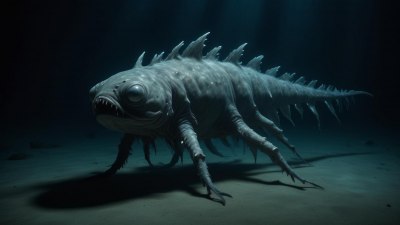How Atmospheric Pressure Affects Deep-Sea Creatures
Explore the impact of atmospheric pressure on deep-sea ecosystems and the adaptations of marine life.

This image was created with the assistance of Freepik
Deep-sea creatures inhabit one of the most extreme environments on Earth. With depths reaching over 36,000 feet in the Mariana Trench, these organisms endure pressures that can exceed 1,000 times the standard atmospheric pressure at sea level. Understanding how atmospheric pressure affects deep-sea creatures is crucial for grasping their biology, behavior, and the ecological dynamics of the deep ocean.
Atmospheric pressure decreases with altitude; however, in the depths of the ocean, the pressure increases significantly. For every 10 meters (about 33 feet) of depth, the pressure increases by approximately 1 atmosphere (atm). By the time we reach depths of around 1,000 meters (3,280 feet), creatures experience pressures that can be around 100 atm, or about 2,200 pounds per square inch (psi). Such levels of pressure create unique challenges that deep-sea organisms must overcome.
Physiological Adaptations
Many deep-sea creatures have developed specialized physiological adaptations to survive and thrive under high-pressure conditions. One of the primary adaptations observed is the lack of air-filled cavities. Unlike shallow-water fish, many deep-sea species, such as certain species of fish, have no swim bladders, which would collapse under immense pressure. Instead, they possess flexible bodies and specialized structures that allow them to maintain buoyancy without relying on gas-filled cavities.
For example, the anglerfish showcases an incredible adaptation, with a body that is often gelatinous and devoid of air. This adaptation helps the anglerfish to withstand the crushing depths of the ocean while still being pliable enough to hunt for prey effectively. The density of their bodies is similar to that of the surrounding water, enabling them to conserve energy while moving through their environment.
Biochemical Changes
Deep-sea creatures also exhibit significant biochemical changes that improve their ability to function under high pressures. Proteins and cellular processes adapt to remain functional at lower temperatures and higher pressures. Research has shown that the enzymes produced by deep-sea organisms often have altered structures, allowing them to perform efficiently despite the challenging conditions. For instance, certain deep-sea bacteria can produce enzymes that not only function well in extreme pressure but also excel at higher temperatures.
The lipid composition of cell membranes in these creatures is another critical adaptation. Membranes are often made of more unsaturated fatty acids, which helps maintain fluidity despite the extreme pressures that would normally cause membranes to become rigid. This membrane adaption is crucial for maintaining cellular processes, nutrient transport, and overall cellular function.
Behavioral Adaptations
Beyond physiological and biochemical responses, deep-sea organisms have also adapted behaviors to cope with their high-pressure environment. Many deep-sea fish use bioluminescence for communication, prey attraction, or predator deterrence. The dimly lit environment of the deep ocean renders visual communication challenging, so bioluminescence becomes an essential tool for survival.
Moreover, deep-sea creatures often exhibit unique feeding strategies. Many of these organisms are opportunistic feeders, capitalizing on the scarce food resources available in their environment. Creatures like the giant squid utilize ambush tactics, allowing them to catch prey efficiently without expending excessive energy.
High-Pressure Systems and Ecosystem Impact
The extraordinary pressures encountered in the deep sea also affect the distribution and types of ecosystems that exist there. Hydrothermal vents, for example, are home to thriving communities of organisms that rely on chemosynthesis rather than photosynthesis. The extreme pressure and the presence of chemicals in the water from the Earth's crust create rich habitats, often teeming with unique species that can withstand such conditions.
These ecosystems are not only fascinating from a biological standpoint but also play important roles in global nutrient cycling. The interactions between organisms at hydrothermal vents, including tube worms and chemosynthetic bacteria, form a unique and complex food web that sustains life in an otherwise inhospitable environment.
The Influence of Human Activity
The increasing interest in the deep sea has resulted in human activities that could impact these delicate ecosystems. Deep-sea mining, trawling, and pollution from surface activities can alter habitats and the distribution of organisms. As we delve deeper into exploring these ecosystems, understanding the unique requirements of deep-sea creatures becomes paramount.
Research indicates that even minor disturbances can have profound effects on deep-sea communities, as individuals exhibit relatively slow growth rates and have longer lifespans compared to shallow-water species. Therefore, conservation measures become critically important to ensure the survival of these remarkable organisms in the face of increasing anthropogenic pressure.
Future Research Directions
There is still much to learn about the impact of atmospheric pressure on deep-sea creatures, and ongoing research is crucial for further understanding these adaptations. Advanced technologies, such as remotely operated vehicles (ROVs) and submersibles, have opened new avenues for exploration. As scientists continue to uncover the mysteries of the deep ocean, they are likely to discover even more adaptations that allow life to thrive under extreme conditions.
Incorporating interdisciplinary approaches that merge biology, chemistry, and ecology can enhance our understanding of deep-sea ecosystems. Additionally, collaborations between scientists, conservationists, and policymakers are essential for developing successful management strategies for these precious environments.
The impact of atmospheric pressure on deep-sea creatures is a complex topic that encompasses various biological, biochemical, and ecological perspectives. From physiological adaptations that enable survival under immense pressure to unique behaviors that facilitate feeding and communication, deep-sea organisms are truly remarkable. As we continue to explore and study the deep ocean, it is imperative to prioritize conservation efforts that safeguard these unique ecosystems from the threats posed by human activity. By protecting these environments, we ensure the survival of fascinating species that have adapted to thrive in one of the most extreme places on Earth.











